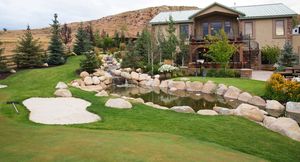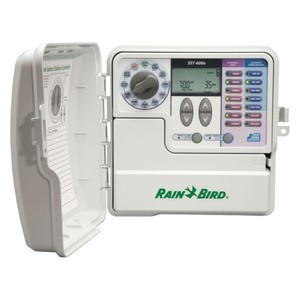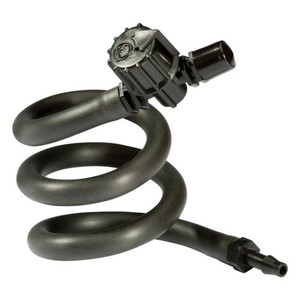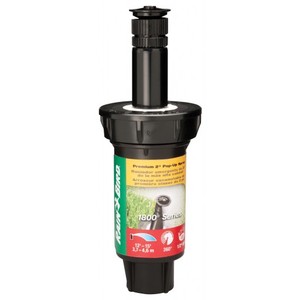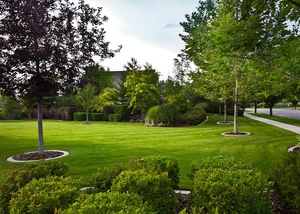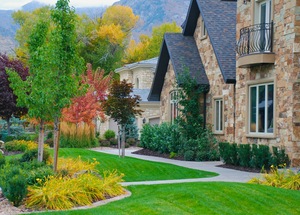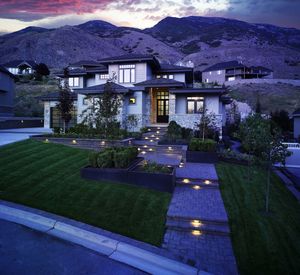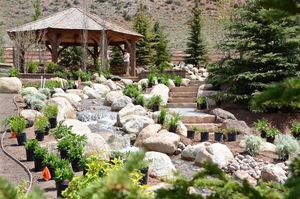IRRIGATION
The sprinkler system plays a key role in the development and health of your landscape. We design and install each sprinkler system based on the unique requirements each landscape presents. Regardless of the project, each landscape will have separate zones for plants and grass. Plant material requires less water than grass and so these systems must be separate! Our lawn care experts can help you set up an effective and efficient sprinkler system for your home here in Salt Lake City or anywhere else in Utah. Below are some more information and tips about how to give your lawn in the Salt Lake City area or anywhere else in Utah the care it needs.
You will find the stations for grass on “Program A” and the stations for plants on “Program B” on your timer. Depending on the time of the year, the watering times will need to be adjusted. As you observe your landscape, you might note that the lawn is browning up based on heat or wind. You would want to increase the water. You might notice that certain plants seem to be struggling. After checking, you find that the soil is very wet. You would then want to decrease the time and dry it out.
CLOCK/CONTROLLER
When the grass is first installed, it is very important to keep it wet- especially with the heat and wind we get. We will monitor the first two weeks carefully, but we always ask for your help. When other lawn care contractors in Salt Lake City are involved with sprinkler installation (new home construction) we have noticed that the timer has been turned off or unplugged. A day without water on new grass is a significant problem. Please make sure that no one messes with your timer.
Before the lawn is mowed for the first time, we recommend turning the timer off for one day to let the lawn dry out. This minimizes any damage to the grade. Simply turn the clock to “off”.
Each timer comes with a set of directions. We encourage you to become acquainted with the operation of your timer and if you have questions, please call us. Because we deal with 4 different seasons, you will need to take responsibility to adjust your timer based on the different seasonal demands.
In the spring, we recommend conservative watering. You will train your grass and plants on how much water they need. Deep watering draws the roots deep and creates healthy plants and grass. This is best accomplished by watering for longer periods less frequently.
As we move into the heat of summer here in the areas around Salt Lake City, sprinklers will require more time. Most clocks have a % feature which simply allows you to increase or decrease the percent of water being delivered. As fall emerges, start decreasing the length of time and the number of days.
We recommend giving all your plant material a thorough watering in the late fall for required moisture and preparation for dormancy.
SPRINKLER HEADS
When we install your sprinkler system, we go through and adjust each head. However, these heads tend to require additional fine-tuning. Standard use and varying site conditions demand some attention. Prior to leaving your project, we will instruct you on the way to adjust these heads. As a reference, these are the types of heads that we work with:
-
Drip System. With a drip line, the biggest need is to make sure that the small spaghetti lines do not get disconnected as a result of people or animals walking through the flower beds. They deliver small amounts of water depending upon the nozzle that we install.
-
Pop-up Heads. We use these in flowerbeds or in the lawn. A pop-up sprays a constant stream without any rotation. The head is fixed. If the adjustment is off, those areas will not be watered. We use a head that has an adjustment built right into it (VAN-variable adjustable nozzle). All you need to do is twist the top to increase or decrease the radius. These heads tend to be knocked by lawnmowers or edgers and are quick and easy to re-adjust. At times, winds will come through an area and necessitate an adjustment. In order for the spray to hit the desired area, you might need to overspray so that the wind blows the spray onto the desired area. A pop-up head will deliver a constant stream to a dedicated area so they should be run for shorter periods of time.
-
Rotor Heads. These are the most difficult to adjust. They require a plastic tool which we will leave with you. These heads are used in the lawn to cover larger areas. Because they are gear driven, they rotate and spray a stream of water. You can adjust: a) the radius (0-360 degrees), b) the amount of water coming out the nozzle (by changing the actual nozzle) and c) the distribution of spray. By choking down on the nozzle, you will create more spray to cover areas up close to the head and decrease the reach. You might find that you need to minimize distance and create more of a misting effect. Please put the adjustment tool in a safe place. A rotor will distribute a spray of water over an area and then rotate back and forth. Rotors need to be on for much longer periods of time because the water to a dedicated area is not constant.
GRASS
A well-maintained lawn creates a stunning effect on any home. While a lawn requires mowing, it is quite easy to maintain. We will share several things we have learned over the years in our maintenance business to help ensure the health and beauty of your lawn.
-
Mowing. You will want to mow your lawn weekly to maintain the appearance. We recommend keeping the grass longer. Do not cut at the lowest setting. The heat and wind in Utah dry lawns out quickly and can make lawn care here in Pleasant Grove difficult. The longer the blade, the more the color, moisture and nutrients are preserved. Mulching creates the healthiest lawn because the nutrients are reintroduced back rather than being bagged and taken away. With mulching, you need to be regular and not let the grass grow too long. Bagging is good when there are a lot of walkways or a lot of leaves or debris that end up on the lawn. The sharper your mower blades, the better the cut. You will notice that the blades of grass will look like they have been ripped rather than cut when your blades are dull. A sharp blade will have a great impact on the quality of the cut!
-
Aerating. We recommend aeration in the Spring and Fall as a minimum. Aeration creates a healthy root system. Wait until the second year of growth before you aerate. The plugs are best left on the lawn. Once they dry out, they disintegrate when mowed.
-
Fertilizing. Proper fertilization is extremely important. Each time the lawn is cut, the majority of nutrients (which reside in the tip of the grass blade) are cut. Over time, the grass becomes depleted and turns yellow or anemic. At a minimum, your grass should be fertilized 4 times. In the spring, we recommend an early pre-emergent to control weed growth. This can usually be accomplished with a weed and feed. As the season develops, different ratios of nitrogen, phosphorous and potassium (this is the ratio listed on the bag such as 30-10-10, N-P-K) will need to be applied. A granular application seems to work best because of the slow release and the ability to achieve a better application. As a good rule of thumb, make sure that all concrete areas are swept or blown off before watering. Many sidewalks and driveways have “rust stains” because of the fertilizer that was left after an application.
-
Irrigation. This is extremely important and easy to observe. As stated earlier, deep watering on a less frequent basis is better than a little water more often. We will set your system up with the proper times for each zone. It is possible that some zones will require more or less water over time (ie: a zone at the bottom of a hill that collects water from the hill). If you notice that the lawn is starting to “brown” or “gray up” increase the water. If you notice that only certain spots are “browning out”, a head or two might need to adjusted. Most people tend to over-water and waste a lot of water and hurt their grass and plant material. We encourage you to water late at night or early in the morning so that the heat of the day does not cause a lot of evaporation before the water can soak in- we do live in a desert!
